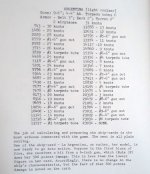GreyLord
Legend
Some thoughts...
Because, as it was derived...a 1 is an automatic miss.
I know...I know...that's not how it works in D&D with the AC vs To Hit Tables...but...
Yes...a 1 is always a miss.
Other reasons...it's guessed at strongly above, but it wasn't due to Chainmail, I don't think (Personal opinion) but the naval rules it was based off of. Also, using a 2d6 means that 2 was the lowest roll.
If your ship was an AC 12, (I know...I know...it only goes up to 9 or 10 depending on the version of D&D), it was automatically hit every time you attacked. No ship was that bad.
A 10 would mean that if you rolled a 10 or lower, you hit. A 9, 9 or lower you hit...and so on and so forth.
If you had an AC of 1, no one would ever be able to hit you (invulnerable ship). An AC of 2 meant that you would have to roll snake eyes to hit this thing...and that was pretty hard to do as well.
That is, until you start using a D12 or D20.
Because, as it was derived...a 1 is an automatic miss.
I know...I know...that's not how it works in D&D with the AC vs To Hit Tables...but...
Yes...a 1 is always a miss.
Other reasons...it's guessed at strongly above, but it wasn't due to Chainmail, I don't think (Personal opinion) but the naval rules it was based off of. Also, using a 2d6 means that 2 was the lowest roll.
If your ship was an AC 12, (I know...I know...it only goes up to 9 or 10 depending on the version of D&D), it was automatically hit every time you attacked. No ship was that bad.
A 10 would mean that if you rolled a 10 or lower, you hit. A 9, 9 or lower you hit...and so on and so forth.
If you had an AC of 1, no one would ever be able to hit you (invulnerable ship). An AC of 2 meant that you would have to roll snake eyes to hit this thing...and that was pretty hard to do as well.
That is, until you start using a D12 or D20.


